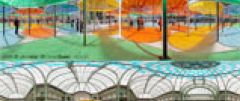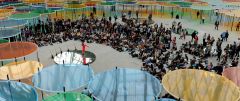Visual tool
The 8.7 cm wide vertical stripes, alternating white and colour, may seem to be the signature of Daniel Buren’s work. But rather than a signature, they are a sign, the only immutable element in his art for over forty years (amidst countless constantly changing elements). There are good reasons for this.
In 1965, when Daniel Buren was busy painting and already interested in bands of colour, he spied a striped fabric in the famous Saint Pierre textile market in Paris. At first he thought the stripes would make an interesting background for a painting: “This pattern has two advantages: firstly it stands out and cannot be taken for a neutral background; and secondly it can be used as a guide for whatever is put on the canvas.” That made him realise that the painting’s environment was more arresting than the painting itself. It then occurred to him that the striped motif was a tremendous revelatory instrument to be deployed in space. He called it his visual tool.
This tool, judiciously arranged in a given place, can attract attention and at the same time blend into the site: it is this balance which has made it so effective and enabled Daniel Buren to keep using it. Like punctuation marks, the vertical stripes reveal the specific features and dimensions of a site (they function like a measuring instrument); they also incite the viewer to look at a familiar place in a new way; they are a call, a sign, the only unvarying element in a vocabulary which has been renewed from place to place over the years.
Yet the stripes are also a lure: the visual tool must not be regarded as a motif in itself, repeated over and over. The art is not in the sign itself, but in what the sign shows and reveals to an attentive viewer. It is intelligible in its context, just as a word used in different sentences by millions of people over the centuries never says exactly the same thing and takes its particular meaning only from the context in which it is uttered.





